If you ask CEO Jim Rowan, the new Volvo EX90 “is a statement for where we are and where we’re going.” It’s not the first all-electric model from the Swedish automaker but it’s certainly the most powerful and lavishly equipped, serving as a counterpoint to the familiar XC90. To get a sense of what the new model is all about I spent a couple days driving the top-line Twin Motor Performance package around the Southern California coast. Here’s what I learned.
Like much of the auto industry, Volvo is struggling to get a read on where things will go over the coming decade. Just a few years ago, it seemed certain that internal combustion engine technology would rapidly fade away, with battery-electric vehicles coming to dominate the global market. Indeed, the Chinese-owned, Swedish-based automaker was determined to effectively phase out gas and hybrid models by around 2030.
With demand slowing in many markets, however, Volvo now seems ready to extend the life of its internal combustion models a bit longer, CEO Jim Rowan hinted during a recent conversation. But hehe made it clear that Volvo isn’t abandoning its plans to eventually go all-electric. While we’ll be seeing another version of the familiar XC90 this coming year, Rowan is remains confident the 2025 Volvo EX90 will define “where we are and where we’re going.”
After spending a couple days with the 3-row EV in Southern California a couple weeks back I found myself impressed with what Volvo has come up with. Sure, I discovered a few things I found frustrating or not entirely well conceived. But, on the whole, the EX90 has a lot going for it in terms of design, performance and technology. And, of course, as a Volvo, it didn’t scrimp on the safety features the brand long has been known for.
The basics
At first glance, you’d be forgiven for confusing the Volvo EX90 and the more familiar XC90, especially when comparing their silhouettes. Both are 3-row crossovers featuring upright noses and gently sloping rooflines that provided plenty of room for three rows of seats. A closer look up front, however, reveals some key differences, starting with the sealed grille underneath the classic Volvo “Iron Mark” badge.
The EV rides on the automaker’s new SPA2 architecture, a platform designed exclusively for EV applications, meaning the battery pack and motors have moved underneath the crossover’s flat load floor. There’s no need to drive air under the hood since there’s no engine compartment. EX90 does feature smaller air intakes below the front bumper to help chill the battery back, motors and front brakes.
Aerodynamics had a heavy influence on the overall design of the new EV – no surprise as this is the easiest way to maximize range – but Volvo stylists did make a few welcome concessions, like offering buyers a choice of 20, 21 and 22-inch tires, depending upon trim and options.
One of the EV’s most distinctive features: a small blister directly above the windshield where EX90’s LiDAR sensor is located. I’ll explain that in more detail a bit further down.
EX90 v XC90
By the numbers there’s not much difference between the 2025 Volvo EX90 and the current XC90. The all-electric model measures 198.3 inches nose-to-tail, about 3.3 inches longer the existing crossover. But it has the exact same wheelbase, at 117.5 inches, and stands about 1.1 inches lower. Surprisingly, the XC90 is slightly wider than the electric model.
Another surprise: interior dimensions are nearly identical, as well. With many – indeed most – other EVs based on skateboard platforms moving powertrain components below the load floor frees up space for passengers and cargo. Here, however, EX90 front row passengers get 44.2 inches of headroom and 40.2 inches of legroom. For those in the second row, the numbers are 41.6 and 36.5 inches respectively. All the way in back, the figures stand at 35.8 inches and 31.9 inches.
For the XC90, the front row measures in at 38.9 and 40.9 inches of headroom/legroom. The second row comes in at 38.5 and 37 inches, the back bench at 36.3 and 31.9 inches respectively.
It’s not entirely a wash. The EV does get a flat load floor, a clear plus for anyone stuck in a middle seat. (EX90 is available with a choice of 6- or 7-seat configurations.) With all seats up, the EV will swallow up to 11.4 cubic feet of cargo in the rear bay. That jumps to 67.6 cubic feet with the second and third rows folded flat – including hidden cargo space.
More Volvo News
- First Drive: Volvo EX30
- Volvo EX90 Finally Enters Production
- Volvo Raises EX90 Prices to Cover Higher Material Costs
Powertrain
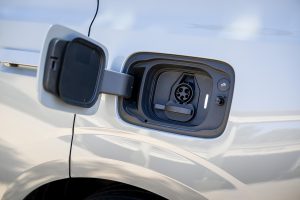
For now, the 2025 Volvo EX90 sticks with a CCS charger port but will later replace it with a Tesla-style NACS connection.
EX90’s SPA2 architecture offers plenty of flexibility when it comes to the powertrain layout. Eventually, we can expect both single and two-motor configurations and, at least in some markets, Volvo will offer different battery pack options. For U.S. buyers, however, the EV launches in 2025 with electric drive units on both axles. Two packages will be offered:
- The EX90 Twin Motor turns out 408 horsepower and 568 pound-feet of torque;
- The EX90 Twin Motor Performance trim bumps that to 517 hp and 617 ln-ft.
Both packages can adjust power distribution fore and aft and EX90 uses torque vectoring to send more power to the outer wheels to improve cornering in tight turns. Both of the initial packages are rated to tow a maximum 4,850 pounds.
Range and Charging
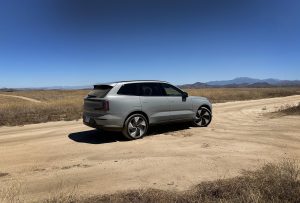
Surprisingly, the EX90 Twin Motor and Twin Motor Performance trims get the same 308-mile EPA range ratings.
Volvo equipped the U.S. version of the EX90 with a 111-kilowatt-hour lithium-ion battery pack – 107 kWh of that actually usable in day-to-day driving.
Curiously, Volvo claims both the EX90 Twin Motor and Twin Motor Performance trims will get up to an EPA estimated 310 miles per charge, depending upon the wheels chosen. How they managed to pull that off considering the significant boost in power for the Performance edition no one at Volvo is explaining.
With charging times, it all depends on what you plug into. This is a big battery pack and using a Level 2 home charger rated at 49 amps you’ll need about 10 hours to take a drained battery up to 100%. Plug into a 400-volt public quick charger rated at 250 kW or more and you’ll go from 20 to 80% in a much more manageable 30 minutes. But with a 50 kW public charger you’ll stay connected three times longer.
Driving impressions
As you’d expect from electric drive, the 2025 Volvo EX90 delivers a peppy launch and linear acceleration. Volvo claims the Twin Motor Performance edition will hit 60 in about 4 seconds, The “base” two-motor package comes in just under 6 seconds. And you’ll hit extra-legal speeds and keep going if you’re not careful. The drivetrain is so smooth and quiet I was grateful to have a head-up display to remind me when I was well into the sort of numbers that can cause serious problems with the California Highway Patrol.
That said, the EX90 is not going to win races against key competitors, such as the Tesla Model X, even with the Twin Motor Performance package.
As with all modern EVs, the EX90 comes with brake regeneration to capture energy normally lost during braking and coasting to return it to the battery pack. And you can activate One-Pedal Mode which translates into a more aggressive form of regen allowing you to slow, even come to a complete stop without taking your foot off the accelerator in many situations. It’s one of my favorite features with EVs and I give demerits to products – such as the Lexus RZ – that don’t have a full One-Pedal mode. That said, I’d like to see Volvo offer an even more aggressive setting, in line with what Cadillac has on the Lyriq.
EX90’s steering is predictable with a reasonable level of feedback coming back through the steering wheel. It’s no sports car but the twin-chamber air suspension minimizes road bumps while also keeping the big SUV reasonably level when blasting through tight corners.
Overall, the EX90 is pleasant to drive and decidedly refined in its overall manners. The cabin is uncannily quiet except on the roughest of pavement where some road noise will intrude. But the overall feel is plush and refined.
Cabin comfort
Some might be disappointed that Volvo didn’t take the opportunity to make a more radical divergence from its existing line-up. For me, though, I’m more than comfortable with the cabin – with a few key gripes I’ll get to shortly.
The automaker’s familiar Scandinavian design approach carries over but here puts an emphasis on both technology and sustainability. As far as the latter is concerned some traditional luxury touches have been swapped out for more sustainable options. Material choices, for example, include gray tailored wool and a leather alternative made from vinyl and pine oil.
The overall layout is familiar and comfortable, the horizontal layout emphasizing the EX90’s width. There’s a big center console with a wireless charger and the cabin boasts plenty of USB ports.
Technology
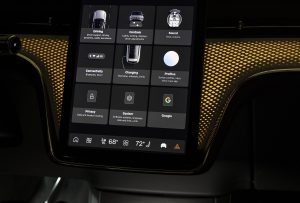
Some normally basic controls — such as side mirrors — require a driver to dig down on the infotainment screen.
Here’s where Volvo decided to push boundaries – and where my feelings for EX90 get a bit ambiguous. I’ve yet to find anyone who likes Volkswagen’s odd approach to letting the driver control all four windows: using just two conventional switches and a third that flips back and forth from front to rear seat. Why Volvo thought that was a better idea no one really can explain, though a couple folks, talking on background, admitted it’s already an issue the automaker may rethink.
Likewise, I’d prefer to see conventional controls for the sideview mirrors and power steering wheel. Right now you have to go two levels down on the infotainment display, tap another button or two and then use the reconfigurable controls on the right side of the steering wheel. I’ve never found it a good idea to make simple tasks more complicated.
Complaining aside, EX90 does offer plenty of welcome tech upgrades, starting with the new Google-based infotainment system that operates off the new, vertically oriented, 14.5-inch touchscreen that rises out of the center stack. (There’s a modest, 9-inch gauge display mounted atop the steering column and my test vehicle featured a useful HUD.)
Connectivity
EX90 features wireless Apple CarPlay and Android Auto, access to Amazon’s Alexa, a smartphone charger and numerous USB ports.
There are some useful apps built into the infotainment system, including the super-high-fidelity Tidal streaming service. It’s a great feature to have considering the EV comes with a Bowers & Wilkinson 25-speaker audio system.
Being a Volvo, of course, there’s one of the broadest suites of digital safety and advanced driver assistance technologies you’ll find in any vehicle. That includes Volvo’s Pilot Assist. In EX90 it adds the ability to change lanes simply by tapping the turn signal stalk.
As I noted earlier, the Volvo EV is one of the first vehicles on the market to add LiDAR sensing on top of its camera and radar sensors. It’s essentially a 3D system that can spot potential objects, under optimum conditions, at up to 1,000 feet away. That’s about 15 seconds of travel at 60 mph. With the notable exception of Tesla, most experts believe LiDAR will be essential to achieve full autonomous driving.
Ironically, EX90 does not features even the more limited hands-free functionality found on many new General Motors and Ford vehicles with their Super Cruise and BlueCruise systems, respectively. A hint? Volvo insiders say upgrades are in the works and would utilize the EV’s smartphone-style over-the-airport technology.
Wrap-up
While I may have my gripes – notably hoping Volvo replaces that weird window controller – I truly enjoyed my time behind the wheel of the 2025 EX90. The Twin Motor Performance pack really does live up to its role as the flagship of what will soon become the Swedish manufacturer’s growing line-up of battery-electric vehicles.
As one would expect, a flagship doesn’t come cheap. The standard EX90 Twin Motor package starts at $79,995 in Plus trim, $84,345 for the Ultra trim. The Twin Motor Performance model starts at $84,995 in Plus trim, $89,345 for the Ultra.
Volvo already has opened the order bank for the 2025 EX90. And you can expect these first two trims to reach U.S. showrooms “later this year,” according to a Volvo spokesman. Lower-priced packages should go on sale later in 2025.

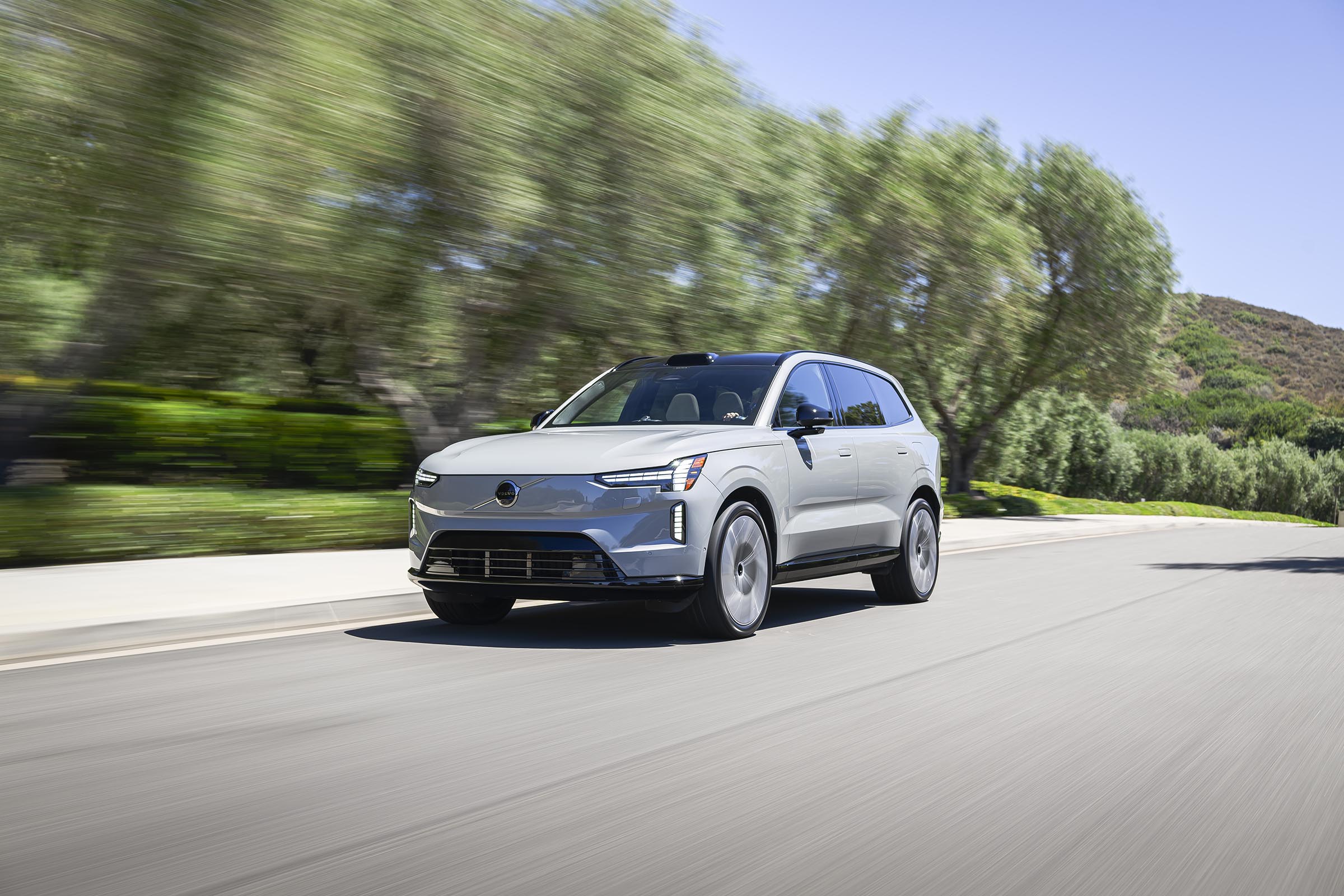
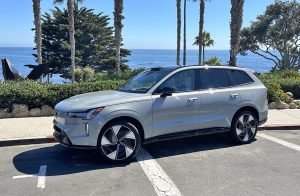
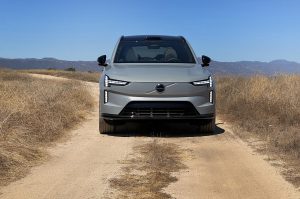
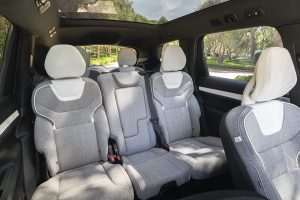
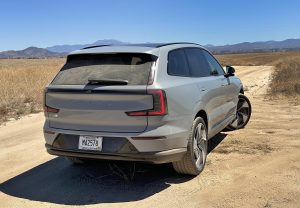
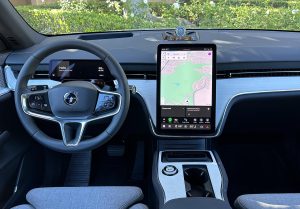
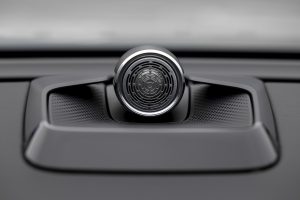
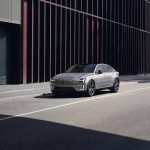


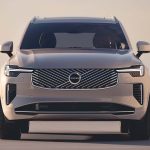


Yawn!
$85,000, tripple yawn!